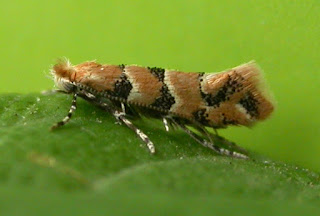Field Guide to the
Micro-Moths of Great Britain and Ireland
British Wildlife Publishing
(2012)
This is a late
review (of sorts), seeing as this book came out about 12 months ago.
I should declare an interest as I was glad to be asked to
help out with the book in terms of collating the photographs for the book. It
features more than 380 photographs of larvae and their feeding signs, and over
half of these are mine, mostly of moth larvae found in the Mersey Valley.
It also features beautiful colour illustrations by Richard
Lewington, Europe’s leading insect artist, of over 1000 micro-moth species.
The micro-moths are a fairly artificial grouping of
approximately 1500 species. Most are (unsurprisingly) small and most are known
by their Latin names, but the variety of life cycles make this a fascinating
group to study.Some of the larvae feed inside a leaf creating a distinctive pattern known as a leafmine. Some feed on dead bark, fungi, wine corks or owl pellets. The seeds, flowers and fruit of almost all plants are potential food for at least one species. Many are extremely specialised and will only feed on one particular foodstuff, often in one particular habitat. The photographs aim to demonstrate these feeding signs as many of the micro-moths may be more easily identified by observation of their early stages than by the adult moth, which is many cases is hard to find.
The illustrations of the adult moths are excellent and
feature the moths in a natural resting position, rather than the unnatural
‘pinned’ appearance, as in a moth collection, that features in some other
books. They also show the moths at 2 or 3 times life-size, and this helps to
show the intricacies of pattern that feature on the wings of many of these
species, despite the actual moths’ miniature appearance.
The photographs below show the adult and
leafmine of one such species, Phyllonorycter trifasciella. The larva of this
moth feeds inside honeysuckle leaves, causing the leaf to twist and turn on
itself, making the presence of the larva reasonably easy to detect. It can be
found in gardens, so if you have any honeysuckle there, have a look to see if
you can see any of these twisted leaves.
This is probably the first time that anything approaching a
handbook has been produced, that covers all the micro-moth families so
extensively, and the book has opened up this area of nature for many more
people. I was pleased to see that there are thirteen reviews of this book on
amazon. Twelve of these give the book 5 stars. The thirteenth gives it four.
The book is available in softback and hardback. There is a
link to the publisher below, although obviously other booksellers are
available.http://www.britishwildlife.com/viewbook.asp?bookid=24
Ben Smart, April 2013





